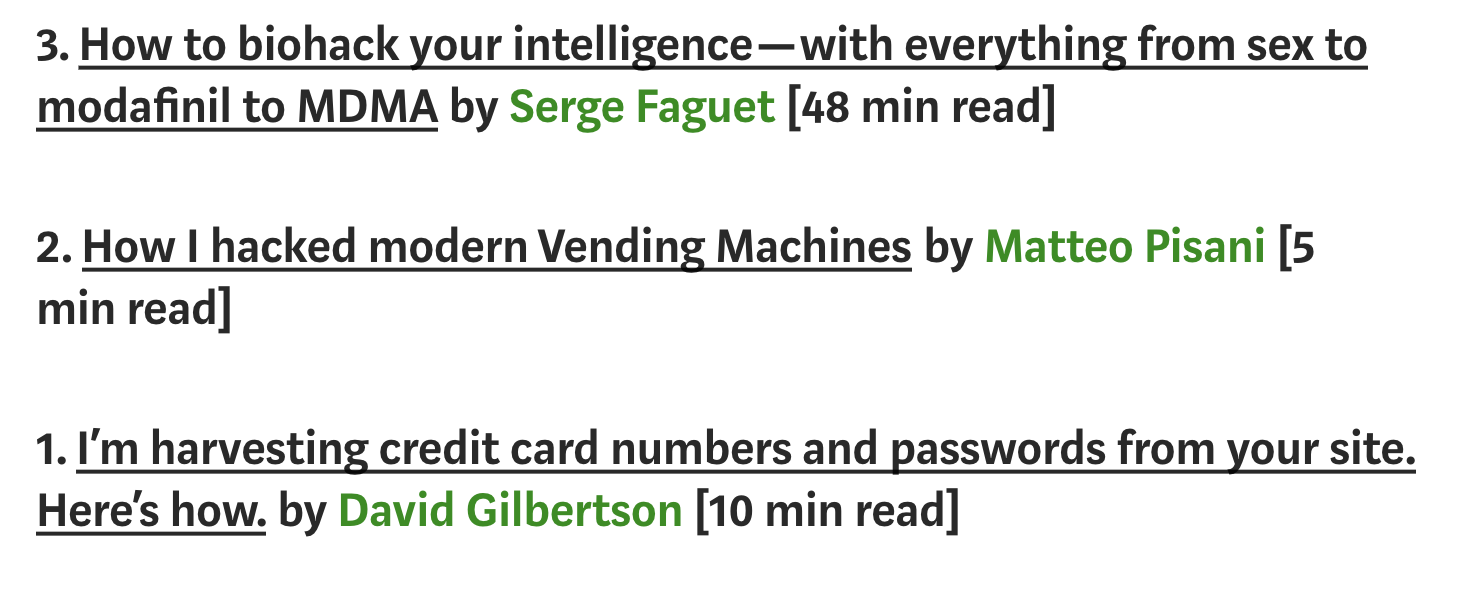最节省时间的编程语言

最近在Facebook上, David Smooke ( Hackernoon的首席执行官)发表了一篇文章,其中列出了2018年的Top Tech Stories 。 他还提到,如果有人希望列出类似的JavaScript清单,他很乐意在Hackernoon的首页上使用它 。
在不断争取更多人阅读我的作品的努力中,我不能错过这个机会,因此我立即开始计划如何制作这样的清单。
由于这一年快要结束了,我的时间有限,因此我决定不手工搜索帖子,而是使用网络抓取技巧。
我相信学习如何制作这样的刮板是一个有用的练习,并且可以作为一个有趣的案例研究。
如果您已阅读有关如何创建instagram机器人的文章,那么您就会知道,使用Node.js与网站进行交互的最佳方法是使用控制Chrome实例的puppeteer库。 这样,我们可以做潜在用户可以在网站上做的所有事情。
这是存储库的链接 。
创建刮板
让我们用这个简单的助手来抽象地创建一个伪造者的浏览器和页面:
const createBrowser = async () => {
const browser = await puppeteer.launch({ headless: true })
return async function getPage<T>(url: string, callback: (page: puppeteer.Page) => Promise<T>) {
const page = await browser.newPage()
try {
await page.goto(url, { waitUntil: 'domcontentloaded' })
page.on('console', (msg) => console.log(msg.text()))
const result = await callback(page)
await page.close()
return result
} catch (e) {
await page.close()
throw e
}
}
}
我们在回调中使用该页面,因此可以避免一遍又一遍地重复相同的代码。 由于这个帮手,我们不需要去看场定的url,从里面听console.logs担心page.evaluate和关闭页万事俱备后。 函数的结果将在promise中返回,因此我们可以稍后await它,而不必在回调中使用结果。
让我们谈谈数据
在一个网站上 ,我们可以找到所有由Hackernoon发布的带有JavaScript标签的文章。 它们是按日期排序的,但是有时会突然出现像2016年这样的文章,所以我们必须提防这一点。
我们可以仅从此帖子预览中提取所有需要的信息,而无需在新选项卡中实际打开该帖子,这使我们的工作更加轻松。

在上面显示的框中,我们看到了所需的所有数据:
- 作者的姓名和个人简介网址
- 文章标题和网址
- 拍手数
- 阅读时间
- 日期
这是文章的界面:
interface Article {
articleUrl: string
date: string
claps: number
articleTitle: string
authorName: string
authorUrl: string
minRead: string
}
在“ 中”上,存在无限滚动,这意味着当我们向下滚动时,将加载更多文章。 如果我们要使用GET请求获取静态HTML并使用JSDOM之类的库进行解析,那么获取这些文章将是不可能的,因为我们不能对静态HTML使用滚动。 因此,当与网站进行任何形式的交互时, p可以挽救生命。
要获取所有已加载的帖子,我们可以使用:
Array.from(document.querySelectorAll('.postArticle'))
.slice(offset)
.map((post) => {})
现在,我们可以将每个帖子用作选择器的上下文-代替编写document.querySelector我们现在要编写post.querySelector 。 这样,我们可以将搜索仅限于给定的post元素。
另外,请注意.slice(offset)片段-由于我们向下滚动而不是打开新页面,因此已经解析的文章仍然在那里。 当然,我们可以再次解析它们,但这并不会真正有效。 偏移量从0开始,每次我们刮掉一些文章时,我们都会将集合的长度添加到偏移量中。
offset += scrapedArticles.length
收集帖子数据
抓取数据时最常见的错误是“无法读取null的'textContent'属性”。 我们将创建一个简单的辅助函数,以防止我们试图获取不存在的元素的属性。
function safeGet<T extends Element, K>(
element: T,
callback: (element: T) => K,
fallbackValue = null,
): K {
if (!element) {
return fallbackValue
}
return callback(element)
}
safeGet仅在element存在时才执行回调。 现在,让我们使用它来访问包含我们感兴趣的数据的元素的属性。
发表文章的日期
const dateElement = post.querySelector('time')
const date = safeGet(
dateElement,
(el) => new Date(el.dateTime).toUTCString(),
'',
)
如果dateElement发生了一些事情,但dateElement它,我们的safeGet将防止出现错误。 <time>元素具有一个名为dateTime的属性,该属性保存文章发布日期的字符串表示形式。
const authorDataElement = post.querySelector<HTMLLinkElement>(
'.postMetaInline-authorLockup a[data-action="show-user-card"]',
)
const { authorUrl, authorName } = safeGet(
authorDataElement,
(el) => {
return {
authorUrl: removeQueryFromURL(el.href),
authorName: el.textContent,
}
},
{},
)
在此<a>元素内,我们可以找到用户的个人资料URL和他/她的名字。
同样,在这里我们使用removeQueryFromURL因为在我们要删除的查询中,作者的个人资料URL和帖子的URL都具有此奇怪的源参数:
https://hackernoon.com/javascript-2018-top-20-hackernoon-articles-of-the-year-9975563216d1? 源=--------
? URL中的字符表示查询参数的开始,因此让我们简单地删除其后的所有内容。
const removeQueryFromURL = (url: string) => url.split('?').shift()
我们将字符串拆分为? 并只返回第一部分。
拍手
在上面的示例帖子中,我们看到“拍手”的数量为204,这是准确的。 但是,一旦数字超过1000,它们就会显示为1K,2K,2.5K。 如果我们需要拍手的确切数目,这可能是个问题。 在我们的用例中,此舍入效果很好。
const clapsElement = post.querySelector('span > button')
const claps = safeGet(
clapsElement,
(el) => {
const clapsString = el.textContent
if (clapsString.endsWith('K')) {
return Number(clapsString.slice(0, -1)) * 1000
}
return Number(clapsString)
},
0,
)
如果拍手的字符串表示形式以K结尾,我们只需删除K字母,然后将其乘以1000,就可以了。
文章的网址和标题
const articleTitleElement = post.querySelector('h3')
const articleTitle = safeGet(
articleTitleElement,
(el) => el.textContent
)
const articleUrlElement = post.querySelector<HTMLLinkElement>(
'.postArticle-readMore a',
)
const articleUrl = safeGet(
articleUrlElement,
(el) => removeQueryFromURL(el.href)
)
同样,由于选择器是在post上下文中使用的,因此我们不需要对其结构过分具体。
“最小阅读量”
const minReadElement = post.querySelector<HTMLSpanElement>('span[title]')
const minRead = safeGet(minReadElement, (el) => el.title)
在这里,我们使用一个稍微不同的选择器:我们寻找一个包含data-title属性的<span> 。
注意:稍后我们将使用.title属性,因此区分它们很重要。
好的,我们现在已经抓取了当前显示在页面上的所有文章,但是如何滚动以加载更多文章?
滚动以加载更多文章
// scroll to the bottom of the page
await page.evaluate(() => {
window.scrollTo(0, document.body.scrollHeight)
})
// wait to fetch the new articles
await page.waitFor(7500)
我们将页面滚动到底部并等待7.5秒。 这是一个“安全”的时间-文章可能会在2秒钟内加载,但我们宁愿确保所有帖子都已加载,而不要错过一些帖子。 如果时间是一个重要因素,我们可能会在请求处设置一些拦截器,该拦截器将获取帖子并在完成后继续前进。
什么时候结束刮
如果按日期对帖子进行排序,我们可以在我们遇到2017年以来的文章时停止抓取。但是,由于在2018年以来的文章之间出现了一些古怪的旧文章,我们无法这样做。 我们可以做的是为2018年或以后发布的文章筛选已删除的文章。 如果结果数组是空的,我们可以有把握地认为有没有更多的文章中,我们感兴趣的是,在matchingArticles我们一直被张贴在2018或更高版本的文章和parsedArticles我们只有被张贴在2018年的文章。
const matchingArticles = scrapedArticles.filter((article) => {
return article && new Date(article.date).getFullYear() >= 2018
})
if (!matchingArticles.length) {
return articles
}
const parsedArticles = matchingArticles.filter((article) => {
return new Date(article.date).getFullYear() === 2018
})
articles = [...articles, ...parsedArticles]
如果matchingArticles为空,我们将返回所有文章,从而结束抓取。
放在一起
这是获取文章所需的全部代码:
const scrapArticles = async () => {
const createPage = await createBrowser()
return createPage<Article[]>('https: //hackernoon.com/tagged/javascript', async (page) => {
let articles: Article[] = []
let offset = 0
while (true) {
console.log({ offset })
const scrapedArticles: Article[] = await page.evaluate((offset) => {
function safeGet<T extends Element, K>(
element: T,
callback: (element: T) => K,
fallbackValue = null,
): K {
if (!element) {
return fallbackValue
}
return callback(element)
}
const removeQueryFromURL = (url: string) => url.split('?').shift()
return Array.from(document.querySelectorAll('.postArticle'))
.slice(offset)
.map((post) => {
try {
const dateElement = post.querySelector('time')
const date = safeGet(dateElement, (el) => new Date(el.dateTime).toUTCString(), '')
const authorDataElement = post.querySelector<HTMLLinkElement>(
'.postMetaInline-authorLockup a[data-action="show-user-card"]',
)
const { authorUrl, authorName } = safeGet(
authorDataElement,
(el) => {
return {
authorUrl: removeQueryFromURL(el.href),
authorName: el.textContent,
}
},
{},
)
const clapsElement = post.querySelector('span > button')
const claps = safeGet(
clapsElement,
(el) => {
const clapsString = el.textContent
if (clapsString.endsWith('K')) {
return Number(clapsString.slice(0, -1)) * 1000
}
return Number(clapsString)
},
0,
)
const articleTitleElement = post.querySelector('h3')
const articleTitle = safeGet(articleTitleElement, (el) => el.textContent)
const articleUrlElement = post.querySelector<HTMLLinkElement>(
'.postArticle-readMore a',
)
const articleUrl = safeGet(articleUrlElement, (el) => removeQueryFromURL(el.href))
const minReadElement = post.querySelector<HTMLSpanElement>('span[title]')
const minRead = safeGet(minReadElement, (el) => el.title)
return {
claps,
articleTitle,
articleUrl,
date,
authorUrl,
authorName,
minRead,
} as Article
} catch (e) {
console.log(e.message)
return null
}
})
}, offset)
offset += scrapedArticles.length
// scroll to the bottom of the page
await page.evaluate(() => {
window.scrollTo(0, document.body.scrollHeight)
})
// wait to fetch the new articles
await page.waitFor(7500)
const matchingArticles = scrapedArticles.filter((article) => {
return article && new Date(article.date).getFullYear() >= 2018
})
if (!matchingArticles.length) {
return articles
}
const parsedArticles = matchingArticles.filter((article) => {
return new Date(article.date).getFullYear() === 2018
})
articles = [...articles, ...parsedArticles]
console.log(articles[articles.length - 1])
}
})
}
在以适当的格式保存数据之前,让我们按拍子降序对文章进行排序:
const sortArticlesByClaps = (articles: Article[]) => {
return articles.sort(
(fArticle, sArticle) => sArticle.claps - fArticle.claps
)
}
现在让我们将文章输出为可读格式,因为到目前为止它们仅存在于我们计算机的内存中。
输出格式
JSON格式
我们可以使用JSON格式将所有数据转储到单个文件中。 以这种方式存储所有文章可能会在将来的某个时候派上用场。
转换为JSON格式归结为键入:
const jsonRepresentation = JSON.stringify(articles)
我们现在可以停止使用文章的JSON表示,然后将我们认为属于该文章的文章复制并粘贴到列表中。 但是,您可以想象,这也可以自动化。
HTML
与从JSON格式手动复制所有内容相比, HTML格式肯定会使从列表中复制和粘贴项目更加容易。
大卫在他的文章中列出以下方式的文章:

我们希望清单采用这样的格式。 我们可以再次使用puppeteer创建HTML元素并对其进行操作,但是,由于我们正在使用HTML ,因此我们可以将值嵌入字符串中-浏览器将始终解析它们。
const createHTMLRepresentation = async (articles: Article[]) => {
const list = articles
.map((article) => {
return `
<li>
<a href="${article.articleUrl}">${article.articleTitle}</a> by
<a href="${article.authorUrl}">${article.authorName}</a>
[${article.minRead}] (${article.claps})
</li>
`
})
.join('')
return `
<!DOCTYPE html>
<html lang="en">
<head>
<meta charset="UTF-8" />
<meta name="viewport" content="width=device-width, initial-scale=1.0" />
<meta http-equiv="X-UA-Compatible" content="ie=edge" />
<title>Articles</title>
</head>
<body>
<ol>
${list}
</ol>
</body>
</html>
`
}
如您所见,我们只是在文章上使用.map()并返回一个字符串,其中包含以我们喜欢的方式格式化的数据。 现在,我们有了一个包含<li>元素的数组-每个元素代表一篇文章。 现在我们只需要.join()来创建一个字符串并将其嵌入到简单的HTML5模板中。
保存文件
剩下要做的最后一件事是将表示形式保存在单独的文件中。
const scrapedArticles = await scrapArticles()
const articles = sortArticlesByClaps(scrapedArticles)
console.log(`Scrapped ${articles.length} articles.`)
const jsonRepresentation = JSON.stringify(articles)
const htmlRepresentation = createHTMLRepresentation(articles)
await Promise.all([
fs.writeFileAsync(jsonFilepath, jsonRepresentation),
fs.writeFileAsync(htmlFilepath, htmlRepresentation),
])
结果
根据抓取工具 ,今年在Hackernoon上发布了894篇带有JavaScript标签的文章,平均每天有2.45篇文章。
HTML文件如下所示:
<li>
<a href="https://hackernoon.com/im-harvesting-credit-card-numbers-and-passwords-from-your-site-here-s-how-9a8cb347c5b5">I'm harvesting credit card numbers and passwords from your site. Here's how.</a> by
<a href="https://hackernoon.com/@david.gilbertson">David Gilbertson</a>
[10 min read] (222000)
</li>
<li>
<a href="https://hackernoon.com/part-2-how-to-stop-me-harvesting-credit-card-numbers-and-passwords-from-your-site-844f739659b9">Part 2: How to stop me harvesting credit card numbers and passwords from your site</a> by
<a href="https://hackernoon.com/@david.gilbertson">David Gilbertson</a>
[16 min read] (18300)
</li>
<li>
<a href="https://hackernoon.com/javascript-2018-top-20-hackernoon-articles-of-the-year-9975563216d1">JAVASCRIPT 2018 — TOP 20 HACKERNOON ARTICLES OF THE YEAR</a> by
<a href="https://hackernoon.com/@maciejcieslar">Maciej Cieślar</a>
[2 min read] (332)
</li>
现在是JSON文件:
[
{
"claps": 222000,
"articleTitle": "I'm harvesting credit card numbers and passwords from your site. Here's how.",
"articleUrl": "https://hackernoon.com/im-harvesting-credit-card-numbers-and-passwords-from-your-site-here-s-how-9a8cb347c5b5",
"date": "Sat, 06 Jan 2018 08:48:50 GMT",
"authorUrl": "https://hackernoon.com/@david.gilbertson",
"authorName": "David Gilbertson",
"minRead": "10 min read"
},
{
"claps": 18300,
"articleTitle": "Part 2: How to stop me harvesting credit card numbers and passwords from your site",
"articleUrl": "https://hackernoon.com/part-2-how-to-stop-me-harvesting-credit-card-numbers-and-passwords-from-your-site-844f739659b9",
"date": "Sat, 27 Jan 2018 08:38:33 GMT",
"authorUrl": "https://hackernoon.com/@david.gilbertson",
"authorName": "David Gilbertson",
"minRead": "16 min read"
},
{
"claps": 218,
"articleTitle": "JAVASCRIPT 2018 -- TOP 20 HACKERNOON ARTICLES OF THE YEAR",
"articleUrl": "https://hackernoon.com/javascript-2018-top-20-hackernoon-articles-of-the-year-9975563216d1",
"date": "Sat, 29 Dec 2018 16:26:36 GMT",
"authorUrl": "https://hackernoon.com/@maciejcieslar",
"authorName": "Maciej Cieślar",
"minRead": "2 min read"
}
]
通过创建一个为我完成所有繁琐,令人麻木的工作的刮板,我可能节省了7-8个小时。 完成后,剩下要做的就是查看热门文章并选择要添加在文章中的内容。 创建代码大约需要一个小时,而手工复制和粘贴所有数据(更不用说以HTML和JSON格式保存)将容易地花费更多。
如果您对查看我选择放入列表中的内容感兴趣,请参阅本文 。
最初于 2019 年1月7日 发布在 www.mcieslar.com 上。
最节省时间的编程语言






















 被折叠的 条评论
为什么被折叠?
被折叠的 条评论
为什么被折叠?








